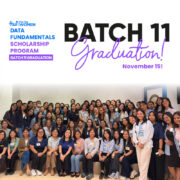The swastika tricycle

“What’s a bat mitzvah?” one of my daughters asked over the weekend, a term she picked up from a movie she was watching on Netflix, with one of her sisters.
Wow, I thought, happy they were watching the same movie on the same device, a rare occurrence these days and which I welcome, especially when it stimulates discussion.
The film my daughters were watching was “You Are So Not Invited to My Bat Mitzvah,” a light American comedy about a Jewish coming-of-age ritual.
I told my daughters about how all cultures have rituals transitioning into adulthood (or at least young adulthood), examples of which are the Latin American quinceañera, for 15-year-old girls (but now, occasionally celebrated for boys too) and the debut in the Philippines for 18-year-old girls. The bat mitzvah for Jewish girls (and the bar mitzvah for males) has a much stronger religious aspect, marked by the celebrant’s public reading from the Jewish Torah, authorizing them to a more active participation, as adults, in religious observances. The reading in the synagogue is fairly solemn but is followed by a very secular party with food (and sometimes drinks) and dancing.
My point was that the bar and bat mitzvah are not just “adulting” rituals but an acquisition of Jewish identity.
I didn’t go into the gender politics of the bat mitzvah, which is allowed only by more liberal Jewish congregations. Being an anthropologist, I wanted to emphasize the cultural variations you find in rituals, religious, secular, or hybrids.
Then I asked the magic question, “You know about Judaism and the Jews, don’t you?”
I was horrified to learn they “sort of” knew but in a very superficial way. They knew of some vague connection with Israel but did not know about the Holocaust. They knew about Palestinians but not about Palestine and the long years of conflict, including the current Israel-Hamas war, that has killed thousands on both sides.
My daughters did not know that the Philippines accepted Jewish refugees between 1934 and 1941, at a time when countries, including the United States, refused to take them in, even as the Jews faced increasing persecution from the Nazis.
I let them finish watching on their own, while jotting down some notes to revive with faculty friends discussions from many years ago to get local schools to include religious studies, not to promote individual faiths but as a comparative course to get people to be more understanding of each other, find commonalities, as well as celebrate differences.
Call it interfaith dialogues, ecumenical encounters, whatever, the point is to get people, especially young people, to recognize religion not as obligatory cultural rituals but as guideposts for life’s many passages, including crises.
Even more importantly, such religious studies sessions should discuss the many examples of how religions are used to justify bigotry, discrimination, even murderous violence.
No doubt, discussions around religions can become tense, especially when there is exceptionalism, i.e., believing that one’s religion is the only true religion, the only path to salvation, and other religions are heretical, reason enough to exclude, if not to exterminate those who don’t share one’s faith.
Religious prejudices spread faster today through the internet. Shortly after the outbreak of the current Israel-Hamas war, I came across a local Reddit discussion thread, quite heated, that seems to have been sparked off by a reader’s post with the caption, “Swastika tricycle.” It was chaotic and confusing as the Reddit community members posted one inflammatory remark after another.
I’ll skip the details and the posts and just share the bombshell to show the extent of our ignorance around religious issues: the so-called swastika was actually the Israeli flag, the “swastika” being the Star of David. Some reader(s) had confused the very different symbols—a star of David and a swastika, not realizing that the Nazis required Jews to wear the star of David on a patch on the left side of their shirts, a patch that marked them for persecution and violence, worn to their last moments as they were sent into gas chambers for the “final solution.”
The need for religious education is all the more urgent now as we find, all over the world, the rise of political leaders who exploit religions to turn people against each other.
I’d add here that well-planned ecumenical religious education would be our best safeguard against religious cults, which is such a serious problem in the Philippines. Religious education must include rationality, helping the young to avoid charismatic and dogmatic religious leaders and to return to the spirit of religion as re-ligare, that which brings people together.
—————-
mtan@inquirer.com.ph


















